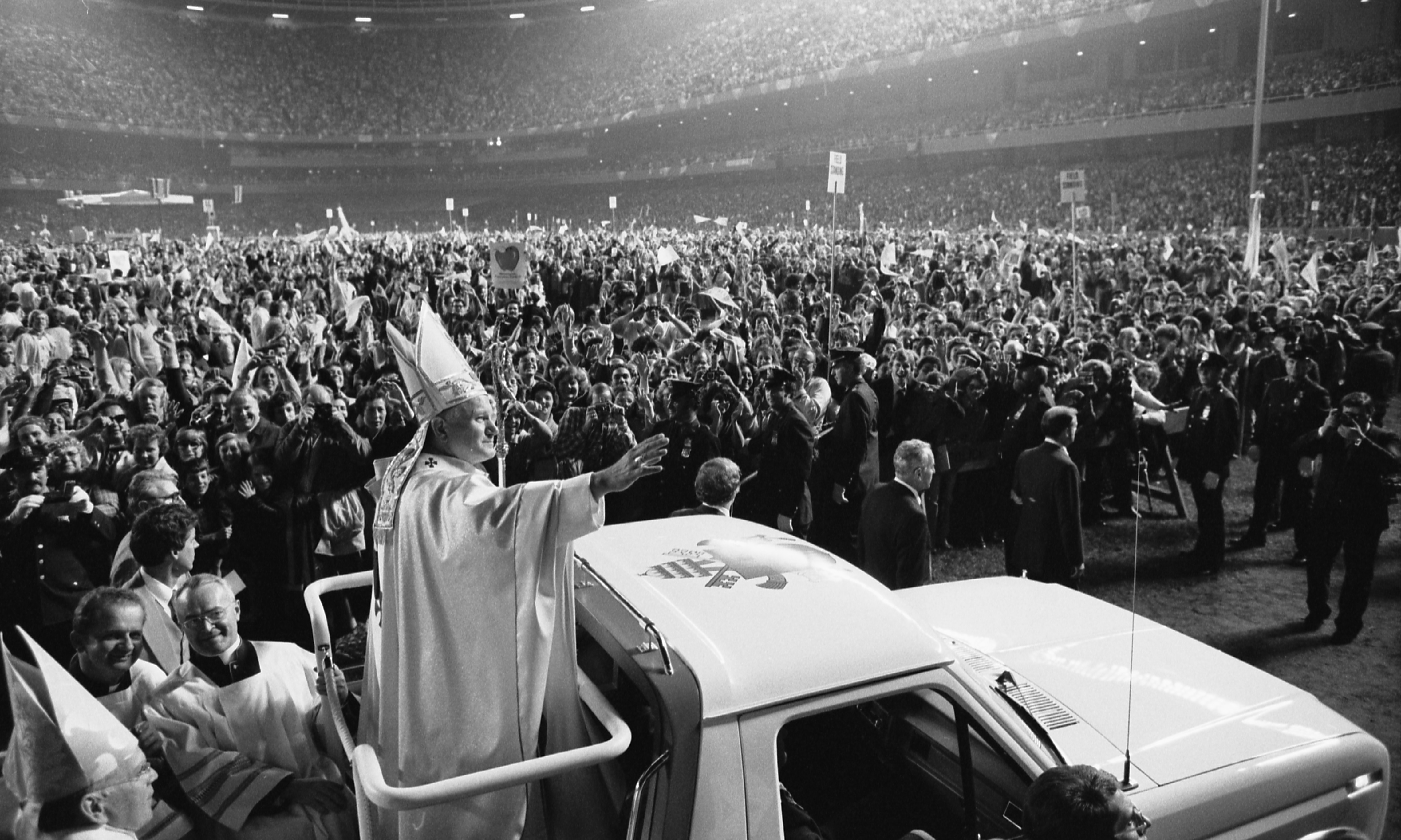At the Saint John Paul II Shrine, just up the road from the Dominican House of Studies in Washington, DC, a series of exhibits chronicles the life of the holy Pontiff and his significance for the Church and the world. The first room, which gives an overview of the chronological tour from his birth in Poland (ninety-six years ago today) through his death in Rome, contains the inscription, “A Light in Darkness.” This title, a reference to the Scriptures about Jesus, shows how the saint brought the light of Christ to the darkened world of the past century.
First, the pope brought light to his native land of Poland. Born shortly after the nation of Poland regained its independence for the first time in over a century, Karol Wojtyła entered university studies as a literature major, but after the Nazis invaded the country and shut down the school, he found his vocation to the priesthood while working at a chemical plant. Continuing his studies at a clandestine seminary as the Nazis gave way to the Communists from the Soviet Union, the future Pontiff sought to restore the light of Christ to his afflicted nation. This was probably best seen years later when Wojtyła was a cardinal: in the Soviet-built “model town” of Nowa Huta, deliberately constructed without a church in sight, Wojtyła strove—and succeeded—to establish a Catholic parish.
Next, he was part of a movement in which Poland shone on the whole world. In an age that saw the earth ravaged by two world wars and several totalitarian regimes, the nation of Poland, caught directly in the crossfire, led the way spiritually for all nations. This article by Fr. Dwight Longenecker details how the fearless leadership of Pope John Paul II, along with the mystical insights on the mercy of God given to St. Faustina Kowalska (a nun whom the Pope would canonize), would remind the world of the saving and loving presence of the God who had become largely forgotten.
John Paul’s efforts were most strikingly displayed during his first visit back to Poland after being elected Pope. On the Vigil of Pentecost, during the dark of night, with many young people surrounding him in the town square of Krakow, the Pope exclaimed in prayer, “Lord, send out your Spirit, and renew the face of the earth—of this land!” The same Holy Spirit who raised Wojtyła to the papacy would work through him to encourage the Solidarity movement to oppose the atheistic Communist state set up in Poland, and ultimately bring about the fall of the Iron Curtain across Europe. Poland, and the whole world in turn, would be renewed by the consoling power of the Paraclete to heal a world broken by sin and its effects. The Pope would then write, thirty years ago today, of this same Spirit’s work through the sacrifice that reunites God with the human race:
One can say that the Holy Spirit is the “fire from heaven” which works in the depth of the mystery of the Cross. Proceeding from the Father, he directs toward the Father the sacrifice of the Son, bringing it into the divine reality of the Trinitarian communion. If sin caused suffering, now the pain of God in Christ crucified acquires through the Holy Spirit its full human expression. Thus there is a paradoxical mystery of love: in Christ there suffers a God who has been rejected by his own creature: “They do not believe in me!”; but at the same time, from the depth of this suffering—and indirectly from the depth of the very sin “of not having believed”—the Spirit draws a new measure of the gift made to man and to creation from the beginning. In the depth of the mystery of the Cross, love is at work, that love which brings man back again to share in the life that is in God himself. (Dominum et Vivificantem, 41)
This merciful love of God for His suffering people, all across the face of the earth, is therefore best seen in the sacrifice of the Cross, in which God the Son took on our weak, mortal human flesh and entered into our suffering. St. John Paul II definitely stayed close to the Cross: intellectually, through his studies and writing on spiritual theology; symbolically, with the humble metal crosier (adorned with a simple crucifix) that he always carried; and physically, not only in Poland’s time of affliction, but especially in the last days of his life.
Let us also embrace the Cross and find consolation whenever we find ourselves in a time of darkness. Through the action of the Holy Spirit, the “Light of our hearts,” the Son and Light of the world reconciles us to the Father of lights, for “the light shines in the darkness, and the darkness has not overcome it” (Jn 1:5).
✠
Image: Artist, Pope John Paul II at old Yankee Stadium, New York City, in October 1979







